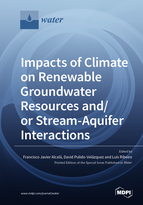Impacts of Climate on Renewable Groundwater Resources and/or Stream-Aquifer Interactions
A special issue of Water (ISSN 2073-4441). This special issue belongs to the section "Hydrology".
Deadline for manuscript submissions: closed (30 September 2020) | Viewed by 21396
Special Issue Editors
Interests: water resource management; techniques and computational applications for modelling of groundwater dynamics at different spatiotemporal scales and climate conditions; applied geophysics
Special Issues, Collections and Topics in MDPI journals
Interests: climate change impacts; adaptation strategies; water resources; hydrology; groundwater; remote sensing; droughts; stream-aquifer interaction; conjunctive use; management models; decision support systems
Special Issues, Collections and Topics in MDPI journals
Interests: groundwater numerical and stochastic models; groundwater and global change; groundwater dependent ecosystems; integrated management of water resources; water in ancestral civilizations
Special Issue Information
Dear colleagues,
The evaluation of aquifer recharge is essential to the quantitative evaluation of renewable groundwater resources and stream–aquifer interactions that is required to implement proper water policies at different spatial and temporal scales. However, aquifer recharge is a broad concept that includes natural sources from precipitation, aquifer transference, losing rivers, and snow melting; non-premeditated human-induced sources from irrigation and urban returns and losing channels and dams; and premeditated human-routed sources from different artificial infiltration techniques. Weather–land attributes, human water requirements, and global climatic forces determine the magnitude of natural sources, the existence of additional human-induced sources when water is used, and the need for human-routed sources in contexts of water scarcity.
A temporal perspective on how climate influences aquifer recharge and, therefore, renewable groundwater resources and surfacewater–groundwater interactions in general is needed. Over the last millennium, climate has determined the renewability of current groundwater resources in many drylands of the Earth. Current global climatic forces, which include the increasing influence of droughts and floods in different terrestrial latitudes, condition future water resources management policies. Finally, global climate scenarios predict the thresholds for future global water availability.
In this broad ‘aquifer recharge–climate’ framework, studies concerning climate influences on all aquifer recharge types that occur over different aquifer, catchment, and landscape typologies at different spatial and temporal scales of observation are welcome. Studies concerning climate influences on human-induced recharge and/or surfacewater–groundwater interactions are welcome. The analysis of climatic patterns and trends, which are drivers of the change in natural aquifer recharge from precipitation, will also be welcome.
Dr. Francisco Javier Alcalá
Dr. David Pulido-Velázquez
Dr. Luis Ribeiro
Guest Editors
Manuscript Submission Information
Manuscripts should be submitted online at www.mdpi.com by registering and logging in to this website. Once you are registered, click here to go to the submission form. Manuscripts can be submitted until the deadline. All submissions that pass pre-check are peer-reviewed. Accepted papers will be published continuously in the journal (as soon as accepted) and will be listed together on the special issue website. Research articles, review articles as well as short communications are invited. For planned papers, a title and short abstract (about 100 words) can be sent to the Editorial Office for announcement on this website.
Submitted manuscripts should not have been published previously, nor be under consideration for publication elsewhere (except conference proceedings papers). All manuscripts are thoroughly refereed through a single-blind peer-review process. A guide for authors and other relevant information for submission of manuscripts is available on the Instructions for Authors page. Water is an international peer-reviewed open access semimonthly journal published by MDPI.
Please visit the Instructions for Authors page before submitting a manuscript. The Article Processing Charge (APC) for publication in this open access journal is 2600 CHF (Swiss Francs). Submitted papers should be well formatted and use good English. Authors may use MDPI's English editing service prior to publication or during author revisions.
Keywords
- Natural, non-premeditated, and premeditated aquifer recharge
- Impacts of climate scenarios
- Available renewable groundwater resources
- Surfacewater–groundwater interaction
- Water resource management policies








